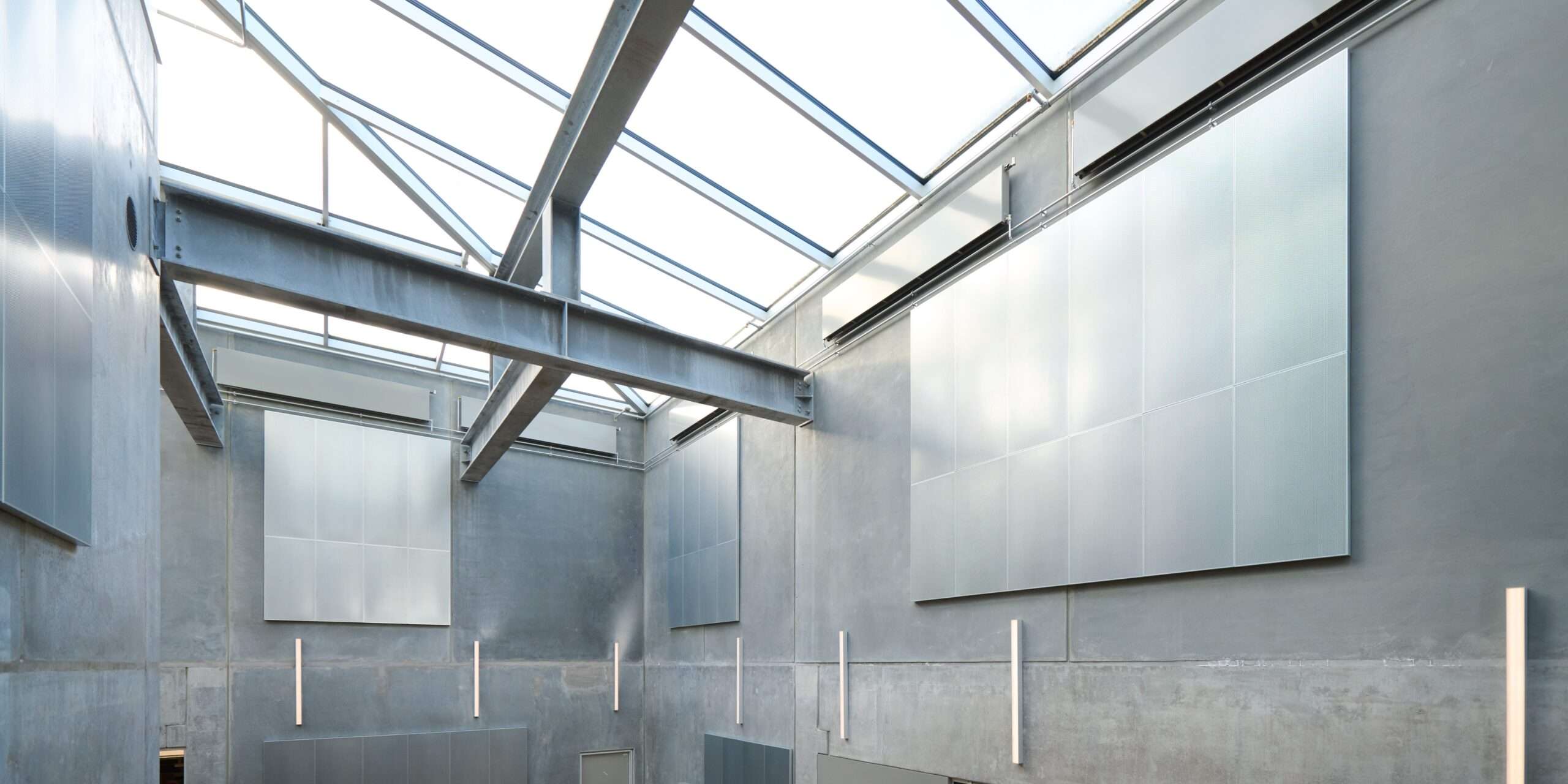DAMPA’s acoustic wall and ceiling solutions can be delivered in absorption classes A, B and C, have a lifespan of more than 50 years, and can be reused for new purposes after the original use.
The new and modern interior style with concrete, steel and high ceilings is popular within the building industry. However, the price for this New Yorker-look is in many cases an acoustic experience, which makes it hard to conduct a normal conversation and spending an entire day in such a space can be directly uncomfortable.
DAMPA wall panels in metal solve the acoustic problem effectively and match the New Yorker style with its different design opportunities.
At the new office for BaneDanmark, there was a lot of concrete in the design. When moving in they discovered problems with the acoustics. We delivered wall panels with a raw galvanized surface. A beautiful steel look, which matched the original design
says Miki Hendriksen, Acoustic Technician at DAMPA.
A similar solution helped a fitness centre in Odense, which also experienced severe problems with bad/poor acoustics. The facilities consisted of concrete floors, concrete walls, and concrete ceilings ten meters high.
After we conducted sound measurements, we installed our Silent Board wall panels to approximately 10 % of the ceiling area. As a rule of thumb, you should install between 10 and 20 %, however, we divided the wall panels on all walls, which quickly and significantly reduced the reverberation time.
Our Silent Board wall panels are a simple and effective way to adjust the acoustics in any space – furthermore, they are easy to install.
tells Miki Hendriksen and continues
Metal and Acoustics
To understand why DAMPA’s wall and ceiling solutions have such a good effect, we need to look at the technique behind sound absorbers. DAMPA has created acoustic solutions in thin metal sheets, this combined with perforations creates a resonance absorbent and a membrane absorbent.
When the sound waves hit the metal and perforation it creates a swinging movement, that absorbs the sound in the lower frequencies. Inside the ceiling and wall panels, the sound meets a porous absorbent, this being the acoustic batts or -felt, which also absorb the sound, more specifically the higher frequencies.
When using three absorbent types, DAMPA can easily fit the acoustic solutions to the room, whether there is a need for an acoustic solution in absorbent class A, B or C.
Easy to Upgrade Your Acoustic Solution
Many locations have DAMPA ceilings installed in the well-known 60×60 tiles. Because of the long lifespan of the ceiling, there are still places with ceilings installed in the 1960s-70s.
These are still acoustic, however, there has been a big development in the requirements for different buildings and their use, therefore many of these locations could use an update to match today’s requirements. In many classrooms, an update of the acoustic solution will benefit the students’ concentration, well-being, and efficiency.
We can easily update the acoustic experience by upgrading the existing DAMPA ceiling with new acoustic batts, which matches the needs and requirements. However, we can also use our DAMPA Silent Board wall panels.
Both solutions are easy to handle – and a whole lot cheaper than replacing the ceiling. Furthermore, it is also much more sustainable to handle an acoustic problem by recycling, rather than producing a brand new ceiling.
Absorbent Class to Match the Pre-Preparatory Classes
At a school, the sound levels are extraordinarily high, especially in the pre-preparatory classes.
A school at Østerbro, Copenhagen had a DAMPA ceiling from when the school was built. The big question was, if they should replace the ceiling, or if it was possible to upgrade the existing ceiling with extra acoustic batts, to live up to today’s requirements. To find the best-suited solution, we started with sound measurements. The measurements showed that the acoustics were close to the contemporary acoustic requirements for schools.
Because the ceiling still functioned so well acoustic and almost lived up to the requirements, we suggested using the walls instead. The acoustic wall panels are closer to the source of the sound: the kids and teachers. Furthermore, the wall panels can easily be fitted to each classroom and the specific needs
says Miki Hendriksen.
DAMPA® Silent Board is produced in absorbent class A. They are normally 50 mm deep with 40 mm acoustic batts.
For this specific project, we have worked on a new custom Silent Board, which is 100 mm deep and with 80 mm acoustic batts. We could call the absorbent class for ‘A-plus’.
This wall panel comes with the same design opportunities as our standard Silent Board, where it is only the imagination that sets limits
says Miki Hendriksen.
New Design Opportunities
With the robust surface of the Silent Board wall panels, DAMPA has created a whole world of new design opportunities.
You can use the natural surfaces of the steel, whatever you wish for a corroded look or the galvanized steel look. Furthermore, it is possible to get DAMPAs acoustic solutions in all RAL- or NCS colours, and it is even possible to choose digital print on the surface, making it custom and personal.
Read more about the unique design opportunities here.


